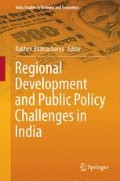Abstract
Seventh chapter onwards the volume again takes state as unit with a set of different parameters to gauge disparity-issue in India, which are sometimes linked to even global issues like the impacts of global financial crises and globalization on India’s regional development outcomes. It also compares with international scenario like in China to understand the degree of internal threat of development-disparity in India. Thus Pinaki Chakravorty in the seventh chapter has analyzed both growth performance and the sources of growth across states. He attempts to link the levels of fiscal imbalance across states and the fiscal space for spending on development outcome in both backward and leading regions of the country. The chapter situates India’s growth and development in the context of the global financial crisis by examining the growth performance across states before and after the global financial crisis and the consequent economic recession. The growth process in post-reform India has failed to benefit all the regions of the country in a uniform pattern. The study interestingly observes that fiscal reforms have largely been revenue-driven via growth. Although, there has been an improvement in the aggregate fiscal position of the states till 2007-08, thereafter, there have been disparities in fiscal performance across states and the transfer system has not been able to offset the fiscal differences across states. Disparities in per-capita spending have increased in recent years. Given increasing fiscal inequality in spending, the author suggests that at policy level, there is a need to correct this trend so that individual state governments are able to provide `comparable levels of public services at comparable levels of taxation’, which has implications for growth.
Access this chapter
Tax calculation will be finalised at checkout
Purchases are for personal use only
Notes
- 1.
However, with continuing global recession compounded with the Eurozone debt crisis, the growth in India has started declining since 2008−2009. The mid-year review of the Indian economy published by the Ministry of Finance for the fiscal year 2012−2013 lowered the growth forecast down to 5.7–5.9 % from 7.6 % estimated earlier.
- 2.
The series of hike in policy rate to contain inflation and renewed concern to bring back the level of fiscal deficit to pre-crisis level has gained momentum.
- 3.
Poverty estimates are taken from the Planning Commission Estimates of Poverty for the year 2009−2010 based on Tendulkar methodology. The web link is http://planningcommission.nic.in/data/datatable/2504/databook_70.pdf.
- 4.
Primary sector comprises agriculture, forestry and logging, fishing and mining and quarrying. Secondary sector comprises of registered and unregistered manufacturing, construction and electricity, gas and water supply. Tertiary sector comprises railways, transport by other means, storage, communication, trade, hotels and restaurants, banking and insurance, real estate, ownership of dwellings, public administration and other services. Agriculture and allied activities imply agriculture, forestry and logging and fishing. The industry sector is the entire secondary sector plus mining and quarrying.
- 5.
Fiscal deficit is the aggregate resource gap of the government to be financed by borrowings. Revenue deficit is the difference between revenue receipts and revenue expenditures.
- 6.
Now, all the states have FRA. Out of these states, except Karnataka, Kerala, Punjab and Uttar Pradesh, all other states have passed the FRA during the fiscal year 2005−2006 with a uniform deficit reduction targets proposed by the 12th Finance Commission (FC). The rush to pass the FRA by the states is clearly driven by Debt Consolidation and Relief Facility (DCRF). Though at the aggregate level, there is a fiscal consolidation at the state level due to rule-based fiscal control with revenue deficit coming close to zero and fiscal deficits below 3 % of GDP by the end of 2007−2008, the outcome of such consolidation requires in-depth analysis of state finances.
- 7.
As mentioned by Rao (2007, p. 1253), this kind of transfers have been ‘undermining the role of systems and institutions in the transfer system. In fact, even under the transfers for state plans, normal assistance, which is given according to the Gadgil formula, constituted less than 48 per cent. Thus, we have a situation where the grants system has become predominantly purpose specific with a cobweb of conditionalities specified by various central ministries. Furthermore, quite a considerable proportion of grants which used to be given to the states now directly go to autonomous agencies. This raises questions about the capacity to deliver public services by these autonomous agencies, mechanisms to augment the capacity and as the funds do not pass through states’ consolidated funds, of accountability’.
Acknowledgment
The author is grateful to Kaushik Bhadra, Amarjyoti Mahanta and Promila Rajvanshi for able research assistance.
Author information
Authors and Affiliations
Corresponding author
Editor information
Editors and Affiliations
Rights and permissions
Copyright information
© 2015 Rajiv Gandhi Institute for Contemporary Studies
About this chapter
Cite this chapter
Chakraborty, P. (2015). Growth, Development Outcome and Fiscal Balance: How Have Indian States Performed?. In: Bhattacharya, R. (eds) Regional Development and Public Policy Challenges in India. India Studies in Business and Economics. Springer, New Delhi. https://doi.org/10.1007/978-81-322-2346-7_7
Download citation
DOI: https://doi.org/10.1007/978-81-322-2346-7_7
Published:
Publisher Name: Springer, New Delhi
Print ISBN: 978-81-322-2345-0
Online ISBN: 978-81-322-2346-7
eBook Packages: Business and EconomicsEconomics and Finance (R0)

